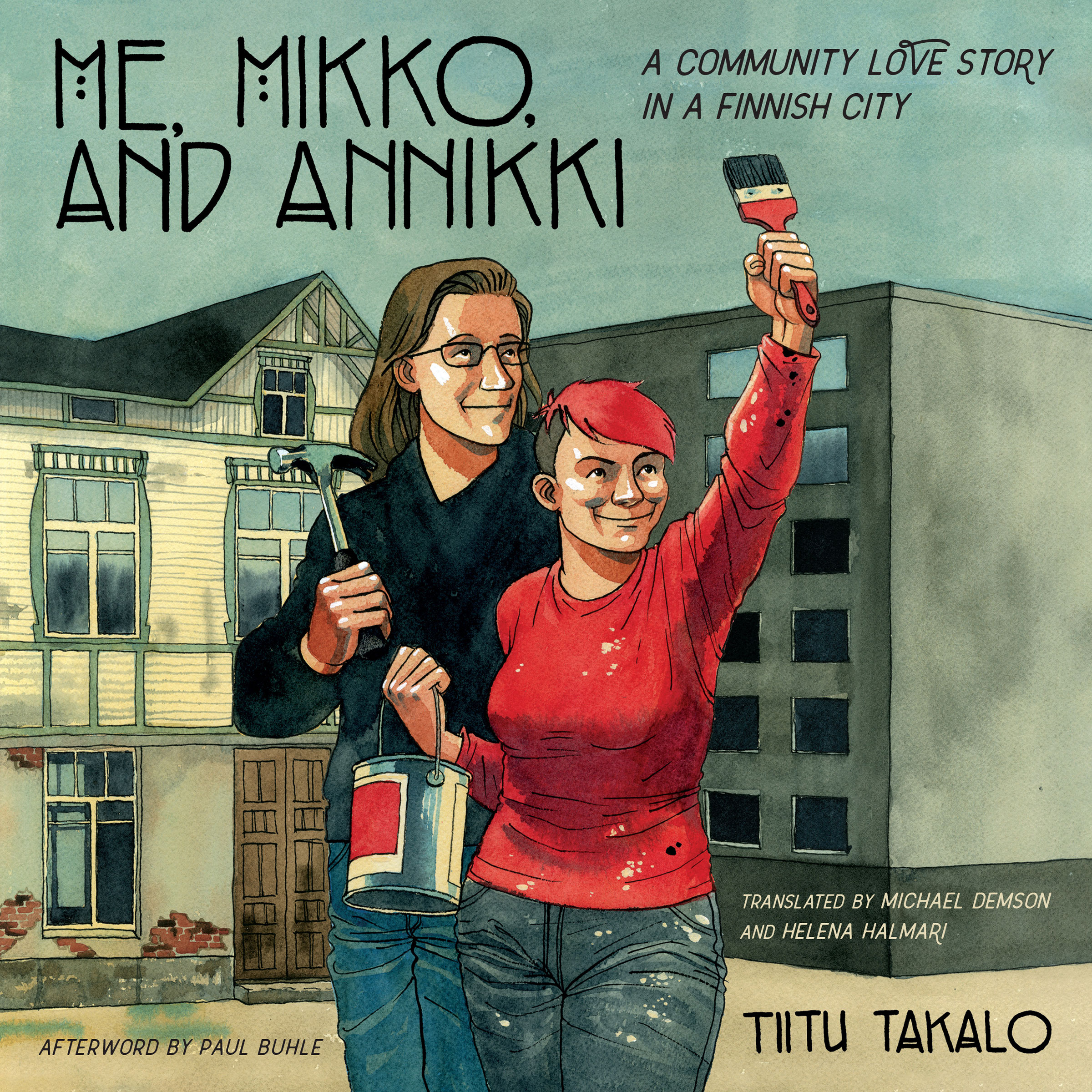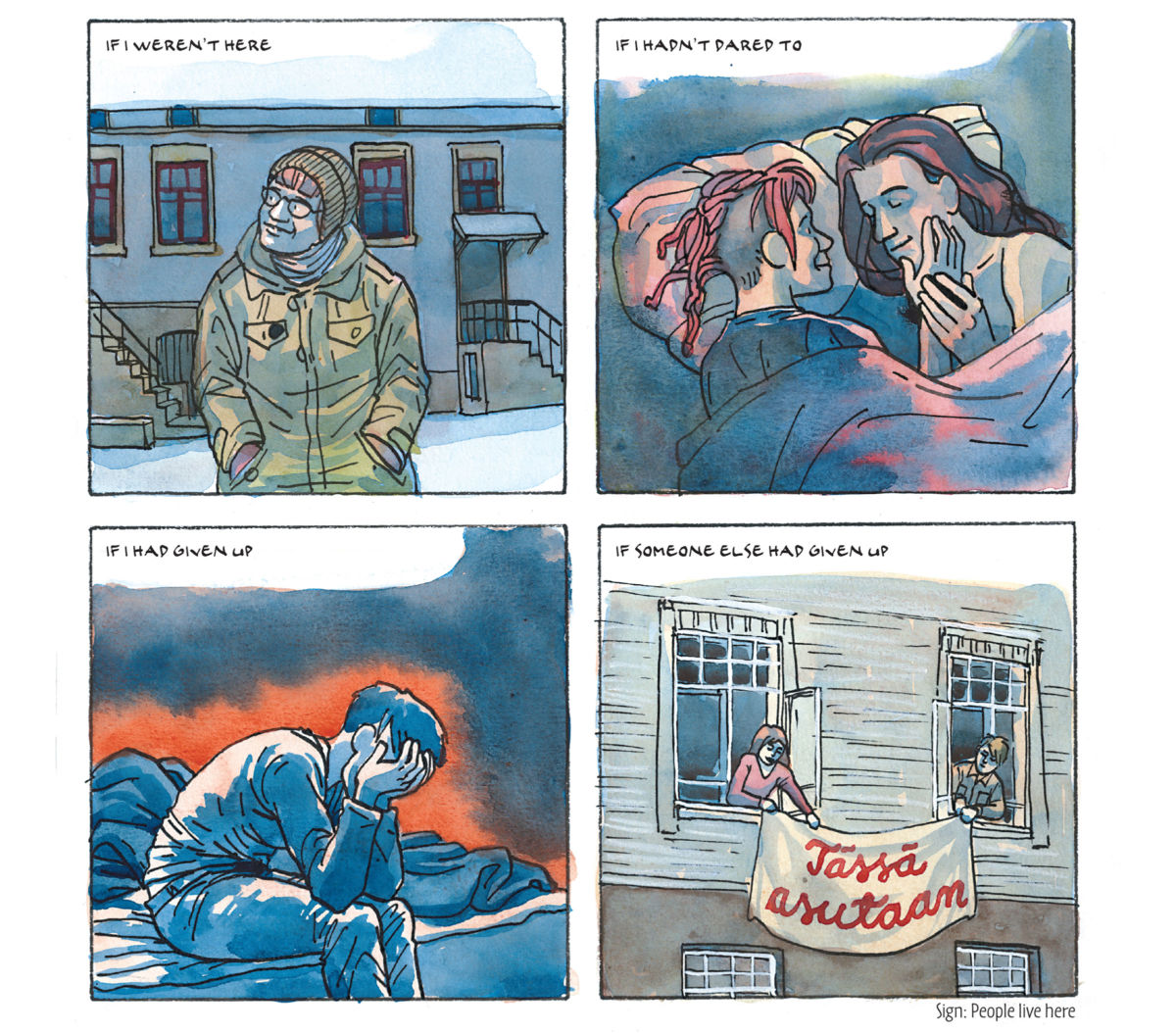Part of the Series
Progressive Picks
The graphic novel, Me, Mikko, and Annikki: A Community Love Story in a Finnish City, is about the fight to preserve the old against irresponsible consumerism, says the book’s translator, Helena Halmari. Together with co-translator Michael Demson, Halmari discusses the universal appeal of the Finnish community of Annikki and how author and artist Tiitu Takalo tells a multidimensional love story that is personal as well as political.
Samantha Borek: Where is the neighborhood of Annikki, and why is it historically and culturally significant in Finland?
Helena Halmari: The neighborhood of Annikki is a wooden block of houses in a section of Tampere, Finland. Right next to this older wooden block, one can see neighboring high-rise buildings. This section of the city is called Tammela, and Tammela has been historically a working-class neighborhood. The Annikki block is significant because a group of active people put up a fight to save this block from demolition. Since the early 2000s, Annikki has gained cultural significance through events like the Annikki Poetry Festival, which takes place in the block every other year. This community-organized event brings both young and established poets from all over Finland and also abroad to read their poetry in the Annikki block. The event has sometimes been described playfully as the “Woodstock for poetry folk.”
How did you find Me, Mikko, and Annikki? What compelled you to translate it for an English-speaking audience?

Michael Demson: I came across a reference to it on Paul Gravett’s English-language blog on comics and graphic novels, where he compiles reader recommendations. The review said that Me, Mikko, and Annikki was Tiitu’s breakthrough masterpiece. I searched for an English translation, which lead me to Tiitu’s own website, where I figured out both that there was no English translation, and that Tiitu was an artist/author with compelling political convictions. At that moment, I thought of Helena…
Halmari: My colleague Michael Demson has himself written a graphic novel [Masks of Anarchy]. He is interested in and knowledgeable about this genre. One day, Michael came to me and asked how I would feel about translating this graphic novel by Tiitu Takalo — Michael had seen pictures of the novel and wanted to read it, but it was not available in English. I am a native speaker of Finnish; I wrote to Tiitu Takalo, and she promised to send us her book. I wanted to be part of this project because the Annikki block is in the city of Tampere, which happens to be the town where I went to college. In fact, I lived the first 34 years of my life just about 20 miles from Annikki, in the town of Lempäälä. I was interested in the story and familiar with Tampere. Tiitu tells the story in an extremely compelling manner. As I read through the Finnish version, I realized that even though the story occurs in merely one wooden block in a Finnish town, it has universal relevance and appeal. It is about the fight to preserve the old against irresponsible consumerism, and it is a story about an incredible community effort, collaboration and perseverance. It is also an autobiographical love story.
The book starts with this blossoming love between the author, Tiitu, and her partner, Mikko, and grows from there. Can you talk about the types of love in the book and how the story evolves in those terms?
Halmari: The story is a love story between the three titular characters: the narrator (Tiitu); Mikko, her partner-to-be; and Annikki, a wooden block in a formerly working-class section of Tampere. The block gets its name from Annikki street — a street named for a female character in the Kalevala, Finland’s national epic. The story revolves around a preservation project launched many years ago to save the block from demolition. Because Annikki in the Kalevala is a female character, the block named after her becomes almost personified — an old lady who needs to be taken care of. The love felt for Annikki, shown by the community of preservation activists and their cooperative efforts, is a leading theme. Another plot line follows Tiitu and Mikko — how a free-spirited young artist meets a guy who, from her point of view, is the worst kind of option: an engineering student in corduroy pants! Tiitu sells one of her comics to Mikko, and they keep running into each other at functions, fall in love, move in together, and decide to apply for an apartment in the Annikki block. Finnish people do not typically talk about love explicitly, but the entire story shows the warm relations between the Annikki folk and their dedication to preserving the old.
Demson: There is a very touching moment in the book when Mikko rescues a table that’s been trashed — he rediscovers its history and restores it with care. As stories within stories often do, this incident reflects the larger plot of the novel: resistance and pushback against those careless and alienating forces that can shape our relations to others — past, present and future. Similarly, there are two pages of illustrations of boots, reminiscent of Van Gogh’s still-lifes of shoes, that Tiitu rescued and wore for years: a quietly powerful meditation on caring for humble things.
The book is broken up into many sections, often fluctuating between style, color and topic. How does that affect the content of the book, and did that play a role in the translation process?
Halmari: The author’s different styles reflect different plot lines. For instance, the narration of the struggles between the preservers and various institutional bureaucracies is depicted in a medieval style — a clever, subtle means by the artist to indicate the “dark ages” imposed by various city, county and national offices, many of which merely want to tear down old buildings and replace them with high rises. The changes of the 1960s are, on the other hand, depicted in straight lines and bold ‘60s colors. The architectural accuracy throughout is amazing.
Demson: I would add that the diversity of styles helps with coherence; shifts in style make shifts in time period and storylines. I am particularly fond of the Sunday funnies style Tiitu uses when she represents her own childhood. If the story of her relationship with Mikko is presented in a fairly conventional manner for contemporary graphic novels, there is a beautiful watercolor painting of him included at the conclusion of the book, along with some other additional materials.
What were some of the challenges in translating the work from Finnish into English? Was there anything you were afraid of losing in the original?
Halmari: The translation process was actually pretty straightforward. I did the “raw” translation, Michael edited the text stylistically, and we also negotiated with Tiitu frequently about the best ways to express some phrases. Tiitu gave us feedback, and the entire process went very well!
Demson: We did run into some difficulty in finding translations that fit well into the existing speech bubbles. Luckily, Finnish words tend to be longer than English equivalents; filling bubbles is easier than trying to shorten the text to make it fit. There are also several places in the novel where the Finnish is embedded in the art itself, such as in signs and posters. In those places, we decided not to change the art but to supply translations, hopefully unobtrusively, beneath the panels. There were some funny moments when Helena translated passages into English that contained English words I didn’t know, like “esker.” What’s an “esker”?
What can we learn from the community in Annikki about preservation rather than gentrification?
Halmari: Preservation requires perseverance, collaboration, hard work and know-how. It is built on a strong ideology of what is good for people in the long run. It’s not about instant gratification of fashion impulses, but long-term dedication.
Demson: I think caring for spaces is the essential groundwork for community. When you care about spaces, you learn their history, you meet your neighbors and share concerns, you invest in their cleanliness and preservation, and this care makes them safer and more beautiful. When you consider places that are unsafe, it is almost always because people do not care for them. There is a moment in the novel in which Tiitu finds a woman passed out behind a dumpster. [Tiitu] hails a bicyclist to get help, and stays with the woman until the ambulance arrives. True community is not something you buy into, but something you have to continually work at to maintain.
We have 10 days to raise $50,000 — we’re counting on your support!
For those who care about justice, liberation and even the very survival of our species, we must remember our power to take action.
We won’t pretend it’s the only thing you can or should do, but one small step is to pitch in to support Truthout — as one of the last remaining truly independent, nonprofit, reader-funded news platforms, your gift will help keep the facts flowing freely.
